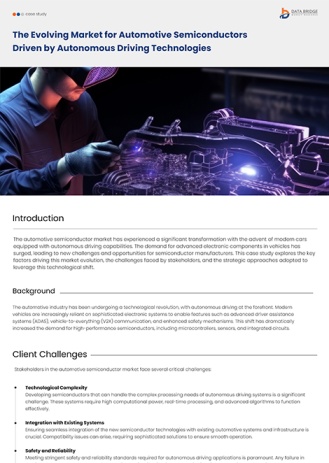Introduction
The automotive semiconductor market has experienced a significant transformation with the advent of modern cars equipped with autonomous driving capabilities. The demand for advanced electronic components in vehicles has surged, leading to new challenges and opportunities for semiconductor manufacturers. This case study explores the key factors driving this market evolution, the challenges faced by stakeholders, and the strategic approaches adopted to leverage this technological shift.
Background
The automotive industry has been undergoing a technological revolution, with autonomous driving at the forefront. Modern vehicles are increasingly reliant on sophisticated electronic systems to enable features such as advanced driver assistance systems (ADAS), vehicle-to-everything (V2X) communication, and enhanced safety mechanisms. This shift has dramatically increased the demand for high-performance semiconductors, including microcontrollers, sensors, and integrated circuits.
Client Challenges
Stakeholders in the automotive semiconductor market face several critical challenges:
Developing semiconductors that can handle the complex processing needs of autonomous driving systems is a significant challenge. These systems require high computational power, real-time processing, and advanced algorithms to function effectively.
- Integration with Existing Systems
Ensuring seamless integration of the new semiconductor technologies with existing automotive systems and infrastructure is crucial. Compatibility issues can arise, requiring sophisticated solutions to ensure smooth operation.
Meeting stringent safety and reliability standards required for autonomous driving applications is paramount. Any failure in semiconductor components can have serious safety implications, necessitating rigorous testing and quality assurance.
Managing the supply chain to address the increased demand and avoid potential shortages is a significant challenge. The semiconductor industry has faced supply chain disruptions in recent years, making it essential to develop robust supply chain strategies.
Navigating the regulatory landscape to ensure compliance with automotive industry standards and regulations is critical. The regulatory environment for autonomous driving technologies is complex and constantly evolving.
Approach/Research Methodology
To address these challenges, a comprehensive approach was employed:
Conducting an in-depth analysis of the automotive semiconductor market, including studying industry reports, competitor analysis, and market trends. This analysis provided a clear understanding of the potential benefits and challenges associated with integrating these technologies.
Identifying specific use cases where advanced semiconductors could deliver significant value. This included enhancing ADAS, improving vehicle connectivity, and supporting autonomous driving functions. Understanding the diverse needs of the automotive industry was crucial to identifying the most effective semiconductor solutions.
Performing a thorough cost-benefit analysis for different semiconductor technologies, estimating the potential return on investment (ROI) for various applications. This analysis helped to prioritize investments in semiconductor development and deployment.
Assessing various semiconductor technologies available in the market, evaluating their compatibility with automotive industry requirements. This included evaluating the performance, reliability, and scalability of different semiconductor solutions.
- Regulatory and Safety Assessment
Conducting a thorough assessment of the regulatory landscape and safety considerations for automotive semiconductors. This involved ensuring compliance with industry standards and addressing any safety concerns associated with new technologies.
Recommendations and Implementation
Based on the research findings, the following recommendations were presented:
- Innovation in Semiconductor Design
Encouraging semiconductor manufacturers to invest in the development of high-performance, energy-efficient chips tailored for autonomous driving applications. Continuous innovation is essential to meet the evolving demands of the automotive industry.
Forming strategic partnerships between automotive companies and semiconductor manufacturers to foster innovation and streamline integration processes. Collaboration can accelerate the development and deployment of advanced semiconductor technologies.
- Enhanced Safety Protocols
Implementing enhanced safety protocols to ensure the reliability and robustness of semiconductor components used in autonomous driving systems. Rigorous testing and quality assurance processes are essential to maintaining high safety standards.
- Supply Chain Optimization
Developing strategies to optimize the supply chain, including diversifying suppliers and increasing production capacity to meet rising demand. Robust supply chain management is critical to avoiding disruptions and ensuring timely delivery of semiconductor components.
Engaging with regulatory bodies to stay ahead of compliance requirements and influence the development of standards that support autonomous driving technologies. Proactive engagement with regulators can help shape policies that facilitate the safe and efficient integration of semiconductors in autonomous vehicles.
Promoting the development of a robust ecosystem that supports the integration of semiconductors with other automotive technologies. This involves collaboration with software developers, automotive OEMs, and other stakeholders to create comprehensive solutions that enhance the capabilities of autonomous vehicles.
- Customer Education and Support
Providing extensive education and support to automotive manufacturers and other stakeholders on the benefits and integration processes of advanced semiconductors. Educating customers about the technological advancements and their applications can drive adoption and optimize implementation.
Outcome and Business Impact
The evolution of the automotive semiconductor market has led to several positive outcomes:
- Technological Advancements
Significant advancements in semiconductor technology have enabled more sophisticated and reliable autonomous driving systems. These technologies have improved the performance, safety, and efficiency of modern vehicles, enhancing their appeal to consumers and automotive manufacturers alike.
The market for automotive semiconductors has expanded rapidly, with increased investments and new entrants driving competition and innovation. The growth has been fueled by the rising demand for autonomous driving technologies and the continuous development of new semiconductor solutions.
- Enhanced Vehicle Capabilities
Modern vehicles equipped with advanced semiconductors offer enhanced safety, connectivity, and autonomous driving capabilities. These improvements have made vehicles more appealing to consumers and have driven the adoption of new technologies in the automotive industry.
The growth of the automotive semiconductor market has had a positive economic impact, creating new jobs and driving revenue growth for semiconductor manufacturers. The demand for skilled professionals in semiconductor design, manufacturing, and integration has increased, contributing to economic development.
Improved alignment with regulatory standards has ensured the safe and effective deployment of autonomous driving technologies. By adhering to stringent safety and reliability requirements, semiconductor manufacturers have contributed to the overall safety and acceptance of autonomous vehicles.
- Sustainability and Efficiency
Advanced semiconductors have enabled more energy-efficient and environmentally friendly automotive technologies. By reducing energy consumption and emissions, these technologies contribute to the sustainability goals of the automotive industry and help address environmental concerns.
Conclusion
The market for automotive semiconductors has transformed significantly with the rise of autonomous driving technologies. The increased demand for advanced electronic components has driven innovation and growth in the semiconductor industry. By addressing the challenges of technological complexity, integration, safety, supply chain management, and regulatory compliance, stakeholders can capitalize on the opportunities presented by this market evolution. The result is a more advanced, connected, and safer automotive landscape, paving the way for the future of autonomous driving.


